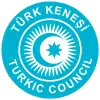Codex Cumanicus
The Codex Cumanicus is a linguistic manual of the Middle Ages, designed to help Catholic missionaries communicate with the Cumans, a nomadic Turkic people. It is currently housed in the Library of St. Mark, in Venice (BNM ms Lat. Z. 549 (=1597)).

Origin and content
It consist of two parts. The first part consists of a dictionary in Latin, Persian and Cuman written in the Latin alphabet, and a column with Cuman verbs, names and pronouns with its meaning in Latin. The second part consists, Cuman-German dictionary, information about the Cuman grammar, and poems belonging to Petrarch.[1]
The first part of Codex Cumanicus was written for practical purposes, which aims to learn languages. The second part was written to spread the Christianity among the Cumans and different quotes from the religious books were given with its Cuman translation. In the same section, there are words, phrases, sentences and about 50 riddles, stories about the life and work of religious leaders.[1]
The Codex likely developed over time. Mercantile, political, and religious leaders, particularly in Hungary, sought effective communication with the Cumans as early as the mid-11th century. As Italian city-states, such as Genoa, began to establish trade posts and colonies along the Black Sea coastline, the need for tools to learn the Kipchak language sharply increased.
The earliest parts of the Codex are believed to have originated in the 12th or 13th century. Substantial additions were likely made over time. The copy preserved in Venice is dated 11 July 1303 on fol. 1r[2] (see Drimba, p. 35 and Schmieder in Schmieder/Schreiner, p. XIII). The Codex consists of a number of independent works combined into one.
Riddles
The "Cuman Riddles" (CC, 119-120; 143-148) are a crucial source for the study of early Turkic folklore. Andreas Tietze referred to them as "the earliest variants of riddle types that constitute a common heritage of the Turkic nations."
Among the riddles in the Codex are the following excerpts:
- Aq küymengin avuzı yoq. Ol yumurtqa.
- "The white yurt has no mouth (opening). That is the egg."
- Kökçä ulahım kögende semirir. Ol huvun.
- "my bluish kid at the tethering rope grows fat, The melon."
- Oturğanım oba yer basqanım baqır canaq. Ol zengi.
- "Where I sit is a hilly place. Where I tread is a copper bowl. The stirrup."
Example
The Codex's Pater Noster reads:
| Cuman |
Atamïz kim köktäsen. Alγïšlï bolsun seniŋ atïŋ, kelsin seniŋ xanlïxïŋ, bolsun seniŋ tilemegiŋ – nečik kim köktä, alay [da] yerdä. Kündegi ötmäkimizni bizgä bügün bergil. Daγï yazuqlarïmïznï bizgä bošatqïl – nečik biz bošatïrbïz bizgä yaman etkenlergä. Daγï yekniŋ sïnamaqïna bizni küvürmägil. Basa barča yamandan bizni qutxarγïl. Amen! |
|---|---|
| English |
Our Father which art in heaven. Hallowed be thy name. Thy kingdom come. Thy will be done in earth as it is in heaven. Give us this day our daily bread. And forgive us our sins as we forgive those who have done us evil. And lead us not into temptation, But deliver us from evil. Amen. |
| Turkish |
Atamız ki göktesin. Alkış olsun senin adın, gelsin senin hanlığın, olsun senin dilediğin – nice ki gökte, öyle de yerde. Bugün, gündelik ekmeğimizi bize ver. Günahlarımızı bağışla – nice ki bağışlarız biz, bize yamanlık edenleri. Ve bizi kötülüğün sınamasından kurtar. Tüm yamandan bizi kurtar. Amin! |
Codex Cumanicus Sources
- Güner, Galip (2016), Kuman Bilmeceleri Üzerine Notlar (Notes on the Cuman Riddles), Kesit Press, İstanbul. 168 pp.
- Argunşah, Mustafa; Güner, Galip, Codex Cumanicus, Kesit Yayınları, İstanbul, 2015, 1080 pp. (https://www.academia.edu/16819097/Codex_Cumanicus)
- Dr. Peter B. Golden on the Codex
- Italian Part of “Codex Cumanicus”, pp. 1 - 55. (38,119 Mb)
- German Part of “Codex Cumanicus”, pp. 56 - 83. (5,294 Mb)
- Schmieder, Felicitas et Schreiner, Peter (eds.), Il Codice Cumanico e il suo mondo. Atti del Colloquio Internazionale, Venezia, 6-7 dicembre 2002. Roma, Edizioni di Storia e Letteratura, 2005, XXXI-350 p., ill. (Centro Tedesco di Studi Veneziani, Ricerche, 2).
- Drimba, Vladimir, Codex Comanicus. Édition diplomatique avec fac-similés, Bucarest 2000.
- Davud Monshizadeh, Das Persische im Codex Cumanicus, Uppsala: Studia Indoeuropaea Upsaliensia, 1969.
External links
- Codex Cumanicus on-line
- Full text of the Codex Cumanicus in Latin
- Golden, Peter B. "Codex Cumanicus". Provides an in depth overview of the book's content.
- Article in Encyclopædia Iranica: http://www.iranicaonline.org/articles/codex-cumanicus
- Complete copy of Ligeti's Prolegomena and Kuun's Latin edition and commentary (as published in Budapest, 1981): https://library.hungaricana.hu/hu/view/MTAKonyvtarKiadvanyai_BORB_01/?pg=0&layout=s
- Ligeti's Prolegomena: https://www.jstor.org/stable/23682271
References
- Codex Cumanicus (Kumanlar Kitabı)
- https://archive.org/details/codexcumanicusbi00kuunuoft/page/n147/mode/2up "MCCCIII die XI Iuly"
| Wikimedia Commons has media related to Codex Cumanicus. |
| Turkish Wikisource has original text related to this article: |

